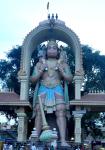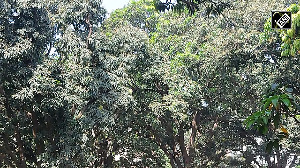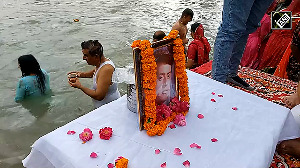When a seemingly open and shut murder case, which fetches a trial court conviction for 12 men charged with the crime on the basis of a questionable eyewitness and Prevention of Terrorism Act confessions, is thrown wide open years later by a high court judgment it becomes the stuff of racy thrillers. The recent Gujarat high court judgment on former Gujarat home minister Haren Pandya's murder provides one such instance.
Eight years after the politician's murder, the Gujarat high court recently acquitted each of the 12 men who had been charged and convicted for the killing. The former Gujarat home minister and Bharatiya Janata Party leader was found murdered on March 26, 2003. Within two days, the Central Bureau of Investigation had, at the state's request, taken over the investigation. Armed with an eyewitness account and POTA confessions it fleshed out a theory of a Muslim conspiracy to avenge the 2002 killings of the minorities in Gujarat. In 2007, a trial court convicted all 12, upholding the prosecution's argument.
On August 29, 2011, the high court, while acquitting all the men, castigated the probe as "botched up and blinkered". This investigation is worth studying for the manner in which the same set of facts pertaining to the murder and presented as evidence produced two totally contrasting responses.
The prosecution case was quite bare. Haren Pandya drove his Maruti 800 to the centrally-located Law Garden where he usually walked every morning. Before Pandya could alight from the car after parking it, from its right appeared a man who shot him five times through a small opening in the driver's window which had not been fully rolled up. The gap was about three inches and no more than a palm's length.
The prosecution produced a street vendor, Anil Yadram Patel, as an eyewitness to the shooting claiming he could identify the assailant Asghar Ali. The investigators claimed that Asghar was part of a group instigated by fanatical cleric Mufti Sufiyan to avenge the 2002 post-Godhra killing of Muslims by targeting Hindu leaders and thus spreading terror.
Lumping Pandya's case with some others under a theory of communal conspiracy made the murder an open and shut terror case. It submerged Pandya's persona while positing the Hindu community as the 'real' victim and target.
That this was not the script of Pandya's murder was proved when the high court looked anew at the 10,000-odd pages of material brought on record during the trial, testing it in light of the principles of criminal law and the law of evidence, aided by the strengths of forensic medicine and ballistics.
Anatomy of a murder investigation
The strength of the prosecution rested on the eyewitness account and Asghar's POTA confession. This turned out to be its biggest weakness. Divergent in almost every respect, the eyewitness account and confession were identical on the one point, which exposed them both as being physically impossible! For, forensic evidence established that most if not all of Pandya's injuries were simply impossible within the car, especially one as cramped as a Maruti 800, and by a firing through a slit of an opening.
This was especially true of one groin injury, caused by a bullet fired at the lower part of the left scrotum and journeying diagonally upwards to the back of the right chest muscle. The prosecution-led witness had clearly tracked this injury in the post-mortem report; the first principle of forensic medicine is to be able to show the track of a bullet's journey.
Further, the same prosecution-led witness categorically stated that the weapon would have to be held below the level of scrotum and to the victim's left to inflict such an injury. This was an impossible feat through a three-inch window opening on the right. Moreover, the circular nature of injuries indicated straight firing from a perpendicular position -- a three-inch window opening would only permit angled shots.
From day one all material facts pointed away from the closed car murder theory. Pandya's clothes were blood soaked but the driver's seat on which he was slumped was spotless. The seven injuries together, suggested two different directions and levels of fire. This meant access to Pandya from all sides and manouevrable space.
Rings of blackening and gunshot residue indicated the entry of seven bullets; only five were found inside Pandya's body. The other two bullets must have exited Pandya's body to fall around the murder spot. But a prompt forensic search of the area produced no sign of the bullets -- in the car or around. The murder could not have been inside the car, but somewhere else, near or far.
Pandya's cellphone found in the car bore no trace of missed calls or messages on the screen, despite assertions of family and friends of repeated calls. Who accessed the phone -- Pandya himself, or someone else?
The former minister's secretary for over a decade, Neelesh Bhatt, had reached the spot before the police. He had told the media that when he opened the driver's door Pandya's feet virtually came on to his (Bhatt's) chest (suggesting a shoving in, possibly). Another report mentioned three of Pandya's walking buddies -- senior bureaucrats and army officers -- who claimed to have walked with him that morning.
At the trial the prosecution maintained Pandya was shot as soon as he had parked the car, at about 7.30 hours. The CBI officer denied knowledge of these reports and furnished such a fanciful explanation for the groin injury (injury number seven) that the high court described thus: "It is unfortunate that the investigating officer has hazarded his own guess in respect of injury No 7 and it is accepted and adapted in the impugned judgment, preferring it over the expert's opinion to the contrary."
Creating the persona of a killer
The CBI created the killer's persona through an incredibly detailed description given by eyewitness Patel (" lean, having a long moustache and deep-set eyes cheeks were curving inside ). Patel's very first account, to his employer had been rather bare, that from his bench inside the park he had seen someone running. The employer's initial statement regarding Anil's description went missing. The high court sharply observed that the prosecution chose not to bring to the trial other local vendors said to have been present at the shooting or soon thereafter, preferring Patel's self-contradictory solo performance.
The CBI described how it traced Asghar. Five local Muslim youths arrested on April 3 and April 4, 2003 by the crime branch apparently confessed to recent incidents of a Muslim terror revenge plan and admitted their complicity in the Pandya murder. The name 'Mehman' (guest) stored in one cell phone was hit man Asghar Ali called from Hyderabad. A number trace, claimed the CBI, led to Asghar's arrest in Hyderabad on April 17, 2003.
However, Asghar's phone records showed no activity or location in Hyderabad in April 2003. The arresting officer changed the arrest narrative. Conveniently, the phone too went missing from CBI's custody.
The CBI used the timing of a call made on Asghar's phone (now missing) at 7.33 hours in the Law Garden area as corroboration of Pandya's murder. Getting a fix on the exact time at which Pandya reached the place was crucial. Yet, Pandya's wife Jagruti, who was the one person who could clarify, was kept away from the trial.
While the CBI claimed to have heard about Asghar on April 3 and April 4, 2003 from the youths arrested in Ahmedabad, its sketch of the murder spot along with the eyewitness' thumb impression, dated March 29, 2003 had the name Asghar Ali written on it! Hidden under a sketch pen's strokes, it showed up through a magnifying glass. The lack of a convincing explanation raised niggling doubts about the organic origin of a Muslim revenge conspiracy and equally about the date of Patel's statements to the CBI.
The CBI claimed Asghar took them to an empty flat in Ahmedabad where they recovered a pistol and revolver. The guns, with bullets said to be from Pandya's body, were sent to Delhi's Central Forensic Science Laboratory. But a mystifying change in the colour and condition of the bullets raised doubts whether they were indeed the same bullets taken from Pandya's body.
The prosecution-led 'expert' was discredited by the trial court, which ultimately held that the eyewitness account and confession were enough to prove the case. They did prove the case, but to the contrary.
Trial court and evidence
So, convinced was the trial court about the eyewitness account of the Pandya case being a closed car murder that it weighed all other material against this given, including reputed expert testimonies. It dismissed the track recorded in the crucial groin injury by conjecturing that " the direction of the bullet inside the body is not something which can follow the set formula as it can strike bone or any thick tissue and can change the direction any number of times."
Where no track was mentioned -- as in the hand and wrist injuries -- the trial court floated its own theory undeterred by the limits of science. As to the crucial extent of opening of Pandya's car window, the trial court held it to be a matter of interpretation not assessment.
In contrast, the high court judgment was completely grounded in the fundamentals of the law. Observing that the medical and ballistic evidence in no way squared with the inherently contradictory account of the eyewitness, the court put a big question mark on his very status as an eyewitness to conclude that the material evidence on record "could not support the conclusions drawn in the impugned judgment as far as killing of Pandya was concerned.
Further, the judgment has commented on yet another puzzling aspect of the investigation to do with the 'kingpin' (as described by the trial court) of the alleged terror conspiracy -- Mufti Soofiyan. Interestingly, the CBI furnished call records to show Soofiyan's presence in Ahmedabad until April 2. On April 3 and April 4, the five young men, allegedly instigated by him according to the investigators, were arrested from a public place. But strangely, the CBI made no attempt to trace Soofiyan ever after that, during which time Soofiyan and his family seem to have vanished. The judgment notes that this is unlikely to have been without the connivance of authorities, which opens up a Pandora's box of unresolved questions.
With the judgment bringing the focus back on the persona of the former home minister, Jagruti Pandya has filed a writ petition in the Gujarat high court seeking reinvestigation of her husband's murder.
There is no getting away from the rigour of the investigative method.






 © 2025
© 2025